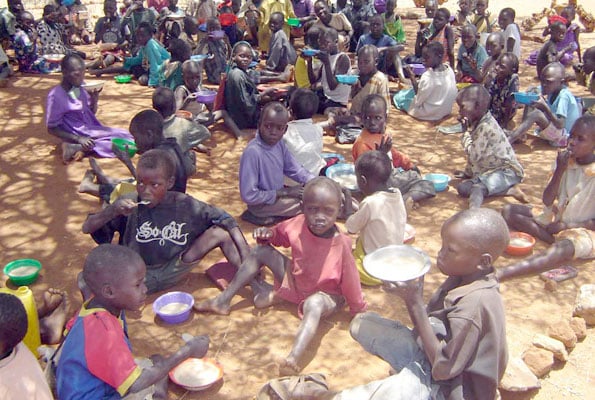Hunger pushes over thousands of children out of school in Oyam

Pupils stand in the queue as they wait to enter their classrooms at Akuca Witim Primary School, Oyam District on March 7, 2024. PHOTO | BILL OKETCH
What you need to know:
- Mr David Adea, the senior education officer, said the dropout rate is over 20 per cent.
Thousands of children are dropping out of school in Oyam District yearly mainly due to hunger brought about by lack of midday meals at learning centres.
A case in point is Kevin Akello, a 13- year-old former Primary Five pupil who dropped out in 2023. Her three siblings living in Wiagaba Village, Aleka Sub-county in Oyam District are not going to school either.
“We are at home because life is very difficult at school. There is congestion in classrooms and not enough space for us to learn. While at school, there is nothing to eat and you have to endure hunger from 8am up to 5pm each day,” Akello explains.
Data from the district education department shows that every year, more than 9,000 are driven out of school in Oyam.
Lack of midday meals and parental involvement, hidden costs of education, teenage pregnancy, child marriage, inability to cope with academic pressure, early exposure to sex and child labour are said to be the driving factors.
In 2020, 2022 and 2023, at least 28,109 pupils dropped out from 56 government-aided primary schools in the area. There are 109 government-aided primary schools scattered in 16 sub-counties and town councils in Oyam District.
Last year, for instance, 9,503 children from the sampled schools dropped out. Sadly, children begin dropping out as they attempt to join formal education. In 2023, at least 1,641 children dropped out of school after joining Primary One. At Apworocero Primary School in Minakulu Sub-county, 20 girls and 15 boys dropped out of school the same year.
Also, 1,031 learners who could have registered for Primary Leaving Examinations (PLE) dropped out of school in the district in 2022. At Wiagaba Primary School in Aleka Sub-county, 16 boys and 13 girls dropped out in Primary Seven that year.
Mr David Adea, the senior education officer, said the dropout rate is over 20 per cent.
“Children always come to school very early in the morning. Sometimes they leave home at 6am. At school, there is no breakfast and lunch and then they go back at 6pm. So, all this time long they are there without anything to eat,” he explained.
He said the attendance is not hugely affected during mango season. Around that period (May and June), learners survive on either unripe or ripe mangoes.
“We have even gone to the extent of asking them to provide only porridge because a lot of maize is being produced around here, but they are so hesitant to do that,” he added.
Indeed, Oyam performed poorly in the 2023 Primary Leaving Examinations (PLE). Out of over 5,000 candidates that sat the final exams last year, only 164 scored first grade while 20.1 per cent got Division U, according to the senior education officer.
‘Congestion in classrooms’
This publication has established that Oyam is struggling to provide quality education to the learners due to the high teacher pupil ratio. On average, one teacher handles 97 children.
“But when you go to other schools, you will get one teacher teaching over 200 children in one class. The enrollment is very high but the number of teachers is low. Up to now, the government has not increased the number of teachers since 2008, when we had a staff ceiling of 1,688 teachers,” Mr Adea said.
‘Hidden costs’
Ms Scovia Akanyo, a parent in Agwec-apoko Village, Ngai Sub-county, said: “Although education is supposed to be free at Universal Primary Education (UPE) schools, most disadvantaged families cannot afford fees for uniforms, scholastic materials, exams and development, leading to school dropout.”
Ms Irene Chelangat Kapsawani, the deputy Chief Administrative Officer, said Oyam District has many child mothers as a result of children dropping out of school at a tender age.
“Oyam has a lot of fertile land, with a lot of farming activities going on and children are engaged in most cases, and that makes them to be enticed to remain at home and don’t go to school,” she said.
“There are 109 government-aided primary and 10 secondary schools and several private primary and secondary schools and even tertiary institutions within the district but the uptake of these services by the community is still a challenge,” she added.
Intervention
Mr Benson Ongom, the district inspector schools, said a special programme intended to bring primary-aged out-of-school children into formal education to learn the first three years of primary education in 10 months was launched in Oyam on March 7, 2024.
A one-year speed school programme implemented by Geneva Global Uganda, a Non-Governmental Organisation caters for children who either dropped out of primary school before acquiring reading and mathematics skills or who have neither attended school at all.
Mr Ongom said a large number of children who have dropped out of school in Oyam have shown interest in returning.
“The government should also join hands with Geneva Global Uganda so that we bring back the dropouts back to school,” Mr Ongom said.
Ms Rebecca Ecwou, Geneva Global Uganda’s country director, said their speed school programme offers beneficiaries the equivalent of the first three years of primary schooling in just 10 months.
“For Oyam District, we have recruited 27 teachers and we are recruiting 900 children to benefit from this programme. But after one year, we expect the parents to have some economic empowerment that can allow them to be able to support their children once we return them into the conventional classes,” Ms Ecwou said.
The programme is implemented in Ngai, Abok, Otwal and Aleka sub-counties, all in Oyam North Constituency.




